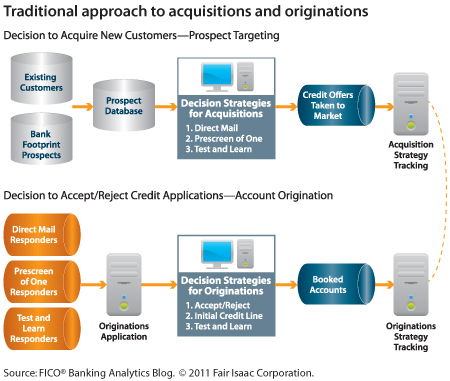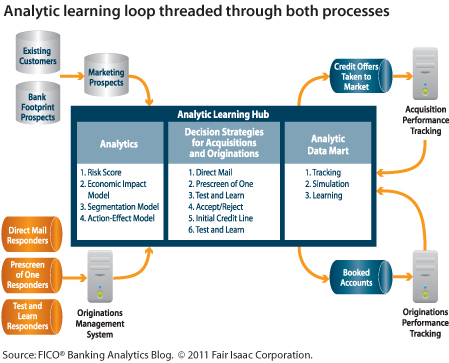Fundamentals of analytic learning loops
My last few posts have discussed the analytic learning loop. By accelerating feedback about market performance, analytic learning loops enable banks to target the right products to…

My last few posts have discussed the analytic learning loop. By accelerating feedback about market performance, analytic learning loops enable banks to target the right products to consumers most likely to respond and generate profits. And banks can adjust decision strategies to boost results while campaigns are still ongoing.
So what does this approach look like?
The fundamental component of an analytic learning loop is an analytic learning hub, through which insights from data analysis and learning from production testing flow. This hub will generally be comprised of analytic data marts (continually refreshed from internal and external data sources), a repository for past treatments, a variety of analytics to monitor what is happening as well as project what might yet happen, and a methodology for creating actionable diagnostic reports.
As shown in the graphic, the learning loop is then "threaded" through both acquisitions and originations processes. This "threading" occurs through shared access to the hub as well as automated data feeds from operational systems, bringing decisioning results and account performance outcomes back to the hub.


The open, hub-based approach is a far less costly and disruptive way to improve visibility and coordination between acquisitions and originations than traditional one-to-one systems integration.
Of course, analytic learning loops are not limited to acquisitions and originations. One of the benefits is that banks can put learning loops in the area of highest priority—which for most companies today is front-end growth—then expand them by hooking other decision areas into the hub. They can also extend learning across lines of business. Or scale analytic learning loops to serve acquired portfolios and new geographic or demographic markets—a practical way to promote best practices, and achieve decision consistency and cost efficiencies across the enterprise.
Popular Posts

Business and IT Alignment is Critical to Your AI Success
These are the five pillars that can unite business and IT goals and convert artificial intelligence into measurable value — fast
Read more
FICO® Score 10T Decisively Beats VantageScore 4.0 on Predictability
An analysis by FICO data scientists has found that FICO Score 10T significantly outperforms VantageScore 4.0 in mortgage origination predictive power.
Read more
Average U.S. FICO Score at 717 as More Consumers Face Financial Headwinds
Outlier or Start of a New Credit Score Trend?
Read moreTake the next step
Connect with FICO for answers to all your product and solution questions. Interested in becoming a business partner? Contact us to learn more. We look forward to hearing from you.
